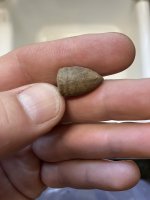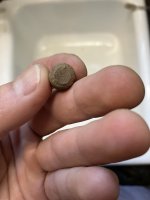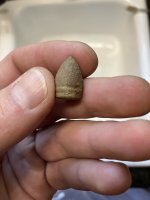Found a little west of Richmond va. Assuming it’s either a very large pistol bullet or a small carbine. Could not find it in M&M. Any help is greatly appreciated. .473-75” dia, .737” length, wt 214.6 grains.
Navigation
Install the app
How to install the app on iOS
Follow along with the video below to see how to install our site as a web app on your home screen.
Note: This feature may not be available in some browsers.
More options
You are using an out of date browser. It may not display this or other websites correctly.
You should upgrade or use an alternative browser.
You should upgrade or use an alternative browser.
✅ SOLVED Bullet id #4
- Thread starter ncsuwolf
- Start date
Solution
You bullet is an unfired civil war Colt "New Model" bullet for .44 revolvers.
Bucket Lister
Bronze Member
- Dec 20, 2023
- 1,064
- 1,927
- Detector(s) used
- XP Dēus II
XP MI-6
XP WSA II-XL
- Primary Interest:
- Metal Detecting
I've got one very similar, but no cigar.
Mine is ~9/16" diameter, ~13/16" long, but same basic shape and ring pattern.
Mine is ~9/16" diameter, ~13/16" long, but same basic shape and ring pattern.
Upvote
0
TheCannonballGuy
Gold Member
- Feb 24, 2006
- 6,586
- 13,320
- Detector(s) used
- White's 6000, Nautilus DMC-1, Minelab
- Primary Interest:
- Relic Hunting
You bullet is an unfired civil war Colt "New Model" bullet for .44 revolvers.
Upvote
4
Solution
TheCannonballGuy
Gold Member
- Feb 24, 2006
- 6,586
- 13,320
- Detector(s) used
- White's 6000, Nautilus DMC-1, Minelab
- Primary Interest:
- Relic Hunting
Yes, your excavated 160-year-old bullet has at least .01-inch (or more) of lead-oxide patina built up on its sides.
According to the Thomas-&-Thomas book ("A Handbook of Civil War Bullets & Cartridges, the bullet when fresh-from the mold measured .455" in diameter. Add one hundredth-of-an-inch of lead-oxide patina, and you're pretty close to your bullet's diameter.
The .455 bullet was loaded into the revolver's cylinder, whose tunnel was manufactured a bit larger than the pistol's .440 bore. Note that the bullet's base does not have an expansion-cavity, so the gunmaker relied on firing-blast to force the "oversized" bullet into the bore's rifling-grooves. Fired Colt .44 bullets often show beautifully sharp rifling-groove marks. I hope that explanation is clear enough to be sufficient.
Don't be fearful or embarrassed to ask such questions. It's how most of us learned what we know... because often the question isn't asked in any book -- or, readily-available book.
For anybody here who doesn't already own "The Handbook of Civil War Bullets & Cartridges":
Regards,
Pete
According to the Thomas-&-Thomas book ("A Handbook of Civil War Bullets & Cartridges, the bullet when fresh-from the mold measured .455" in diameter. Add one hundredth-of-an-inch of lead-oxide patina, and you're pretty close to your bullet's diameter.
The .455 bullet was loaded into the revolver's cylinder, whose tunnel was manufactured a bit larger than the pistol's .440 bore. Note that the bullet's base does not have an expansion-cavity, so the gunmaker relied on firing-blast to force the "oversized" bullet into the bore's rifling-grooves. Fired Colt .44 bullets often show beautifully sharp rifling-groove marks. I hope that explanation is clear enough to be sufficient.
Don't be fearful or embarrassed to ask such questions. It's how most of us learned what we know... because often the question isn't asked in any book -- or, readily-available book.
For anybody here who doesn't already own "The Handbook of Civil War Bullets & Cartridges":
Regards,
Pete
Upvote
6
Top Member Reactions
-
 3530
3530 -
 2036
2036 -
 1750
1750 -
 1464
1464 -
 1211
1211 -
 1190
1190 -
 1061
1061 -
 955
955 -
 858
858 -
 747
747 -
 642
642 -
 595
595 -
 486
486 -
 478
478 -
 475
475 -
E
441
-
 402
402 -
 394
394 -
 381
381 -
 335
335
Users who are viewing this thread
Total: 2 (members: 0, guests: 2)












